Typical values at TA =
+25°C, ADC Sampling Rate = 2949.12 GHz. Default conditions: output sample rate =
491.52MSPS (decimate by 6), PLL clock mode with fREF = 491.52 MHz,
AIN = –3 dBFS, DSA setting = 4 dB.
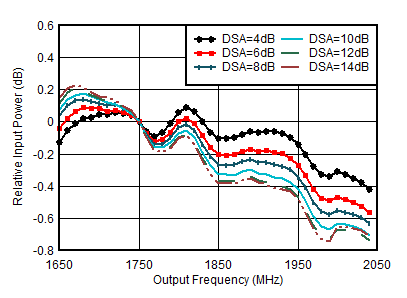
| With
1.8 GHz matching, normalized to 1.75 GHz |
|
Figure 6-318 RX
In-Band Gain Flatness, fIN = 1750 MHz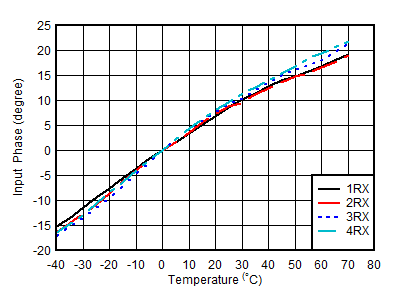
| With
2.6 GHz matching, normalized to phase at 25°C |
|
|
Figure 6-320 RX
Input Phase vs Temperature and DSA at fIN = 1.75 GHz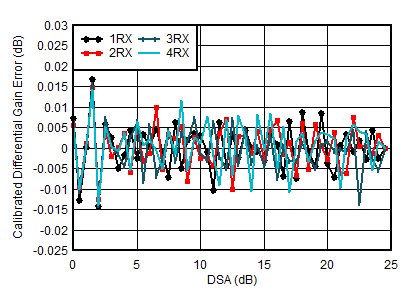
| With
1.8 GHz matching |
| Differential Amplitude Error = PIN(DSA
Setting – 1) – PIN(DSA Setting) + 1 |
Figure 6-322 RX
Calibrated Differential Amplitude Error vs DSA Setting at 1.75 GHz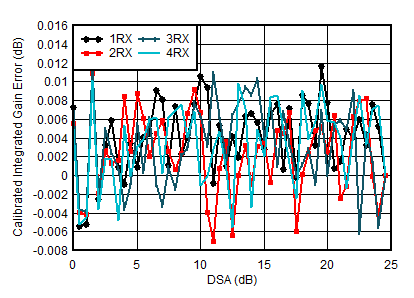
| With
1.8 GHz matching |
| Integrated Amplitude Error = PIN(DSA
Setting) – PIN(DSA Setting = 0) + (DSA
Setting) |
Figure 6-324 RX
Calibrated Integrated Amplitude Error vs DSA Setting at 1.75 GHz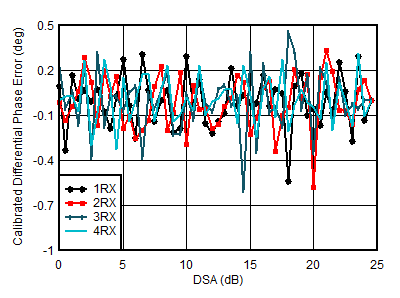
| With
1.8 GHz matching |
| Differential Phase Error = PhaseIN(DSA
Setting – 1) – PhaseIN(DSA Setting) |
Figure 6-326 RX
Calibrated Differential Phase Error vs DSA Setting at 1.75 GHz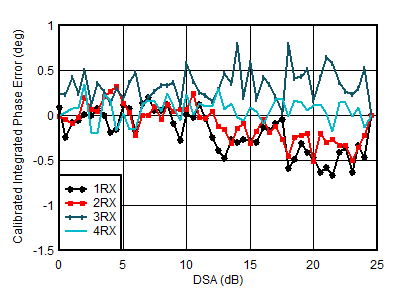
| With
1.8 GHz matching |
| Integrated Phase Error = Phase(DSA Setting) – Phase(DSA
Setting = 0) |
Figure 6-328 RX
Calibrated Integrated Phase Error vs DSA Setting at 1.75 GHz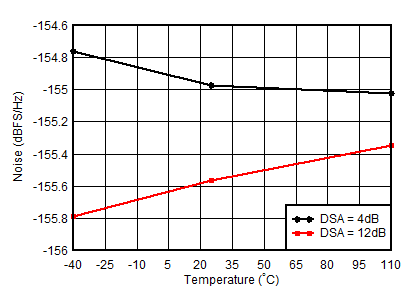
| With
1.8 GHz matching, 12.5-MHz offset from tone |
|
Figure 6-330 RX
Noise Spectral Density vs Temperature at 1.75 GHz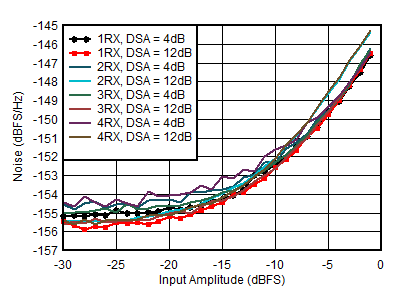
| With
1.8 GHz matching, 12.5-MHz offset from tone |
|
Figure 6-332 RX
Noise Spectral Density vs Input Amplitude and Channel at 1.75 GHz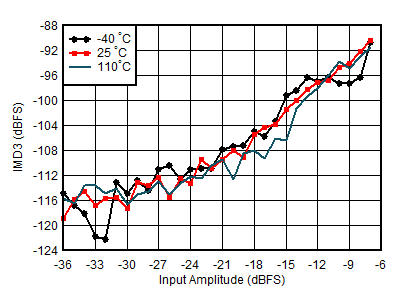
| With
1.8 GHz matching, tone spacing = 20 MHz, DSA = 4
dB |
Figure 6-334 RX
IMD3 vs Input Level and Temperature at 1.75 GHz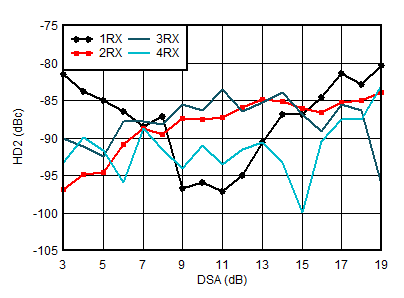
| With
1.8 GHz matching, fin = 1900MHz, measured
after HD2 trim, DDC bypass mode (TI only mode for
characterization) |
Figure 6-336 RX
HD2 vs DSA Setting and Channel at 1.9 GHz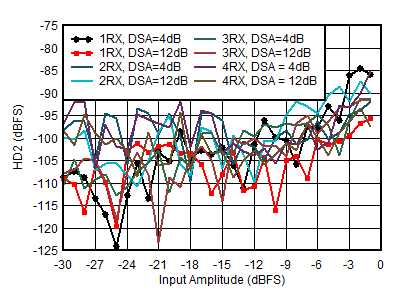
| With
1.8 GHz matching, fin = 1900MHz, measured
after HD2 trim, DDC bypass mode (TI only mode for
characterization) |
Figure 6-338 RX
HD2 vs Input Amplitude and Channel at 1.9 GHz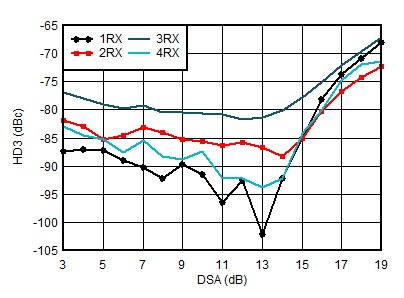
| With
1.8 GHz matching, fin = 1900MHz, DDC bypass
mode (TI only mode for characterization) |
Figure 6-340 RX
HD3 vs DSA Setting and Channel at 1.9 GHz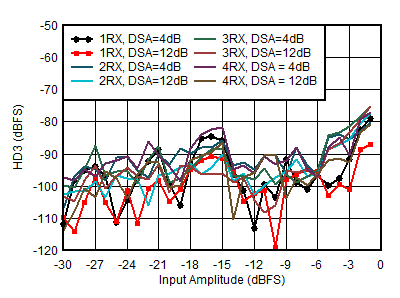
| With
1.8 GHz matching, fin = 1900MHz, DDC bypass
mode (TI only mode for characterization) |
Figure 6-342 RX
HD3 vs Input Level and Channel at 1.9 GHz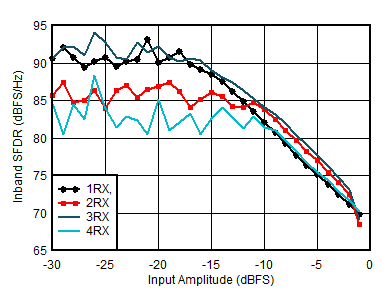
| With
1.8 GHz matching, decimated by 3 |
Figure 6-344 RX
In-Band SFDR (±400 MHz) vs Input Amplitude at 1.75 GHz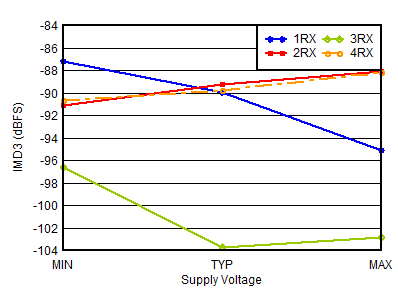
| With
1.8 GHz matching, –7 dBFS each tone, 20-MHz tone
spacing, all supplies at MIN, TYP, or MAX recommended
operating voltages |
Figure 6-346 RX
IMD3 vs Supply and Channel at 1.75 GHz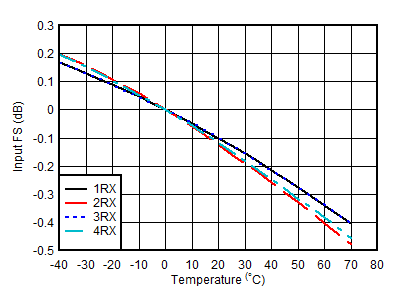
| With
1.8 GHz matching, normalized to fullscale at 25°C for
each channel |
Figure 6-319 RX
Input Fullscale vs Temperature and Channel at 1.75 GHz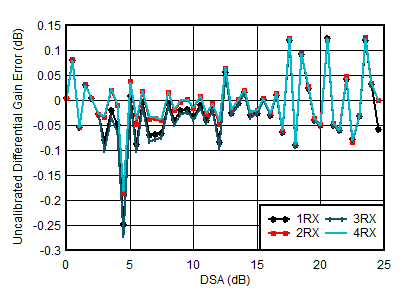
| With
1.8 GHz matching |
| Differential Amplitude Error = PIN(DSA
Setting – 1) – PIN(DSA Setting) + 1 |
Figure 6-321 RX
Uncalibrated Differential Amplitude Error vs DSA Setting at 1.75 GHz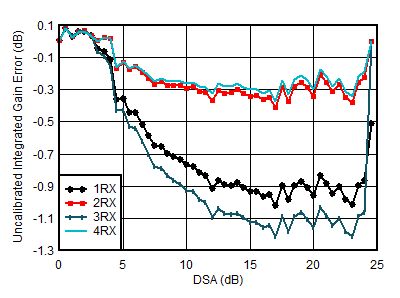
| With
1.8 GHz matching |
| Integrated Amplitude Error = PIN(DSA
Setting) – PIN(DSA Setting = 0) + (DSA
Setting) |
Figure 6-323 RX
Uncalibrated Integrated Amplitude Error vs DSA Setting at 1.75 GHz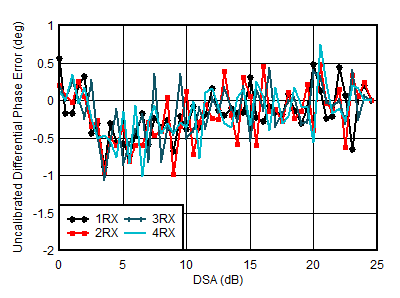
| With
1.8 GHz matching |
| Differential Phase Error = PhaseIN(DSA
Setting – 1) – PhaseIN(DSA Setting) |
Figure 6-325 RX
Uncalibrated Differential Phase Error vs DSA Setting at 1.75 GHz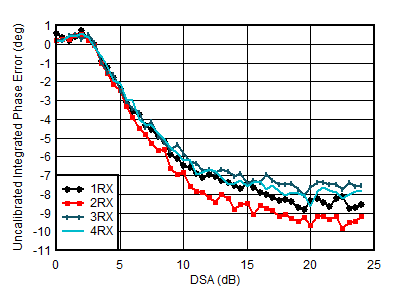
| With
1.8 GHz matching |
| Integrated Phase Error = Phase(DSA Setting) – Phase(DSA
Setting = 0) |
Figure 6-327 RX
Uncalibrated Integrated Phase Error vs DSA Setting at 1.75 GHz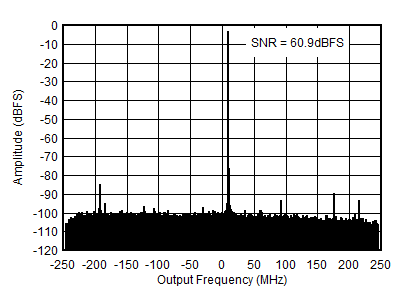
| With
1.8 GHz matching, fIN = 2610 MHz,
AIN= –3 dBFS |
|
|
Figure 6-329 RX
Output FFT at 1.75 GHz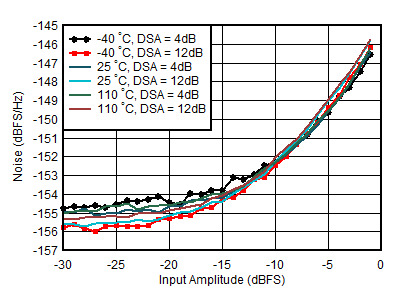
| With
1.8 GHz matching, DSA Setting = 12 dB, 12.5-MHz offset
from tone |
Figure 6-331 RX
Noise Spectral Density vs Input Amplitude and Temperature at 1.75
GHz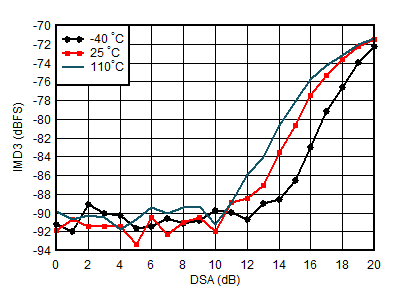
| With
1.8 GHz matching, each tone –7 dBFS, tone spacing = 20
MHz |
Figure 6-333 RX
IMD3 vs DSA Setting and Temperature at 1.75 GHz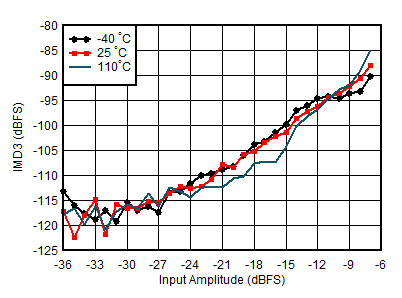
| With
1.8 GHz matching, tone spacing = 20 MHz, DSA = 12
dB |
Figure 6-335 RX
IMD3 vs Input Level and Temperature at 1.75 GHz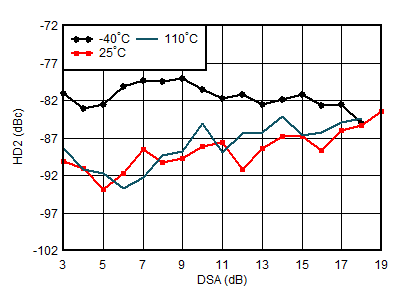
| With
1.8 GHz matching, fin = 1900MHz, measured
after HD2 trim, DDC bypass mode (TI only mode for
characterization) |
Figure 6-337 RX
HD2 vs DSA Setting and Temperature at 1.9 GHz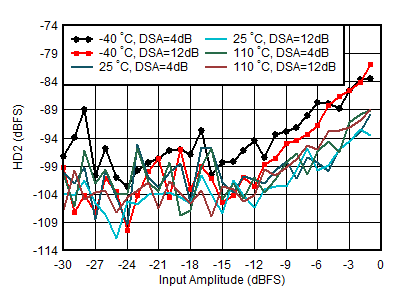
| With
1.8 GHz matching, fin = 1900MHz, measured
after HD2 trim, DDC bypass mode (TI only mode for
characterization) |
Figure 6-339 RX
HD2 vs Input Amplitude and Temperature at 1.9 GHz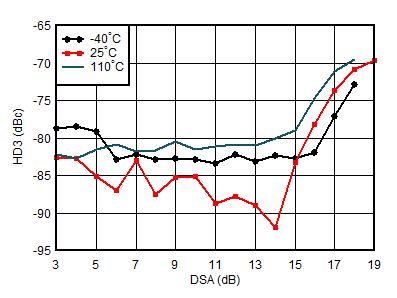
| With
1.8 GHz matching, fin = 1900MHz, DDC bypass
mode (TI only mode for characterization) |
Figure 6-341 RX
HD3 vs DSA Setting and Temperature at 1.9 GHz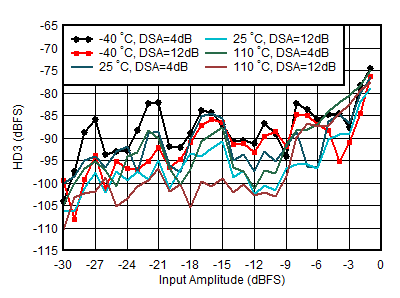
| With
1.8 GHz matching, fin = 1900MHz, DDC bypass
mode (TI only mode for characterization) |
Figure 6-343 RX
HD3 vs Input Level and Temperature at 1.9 GHz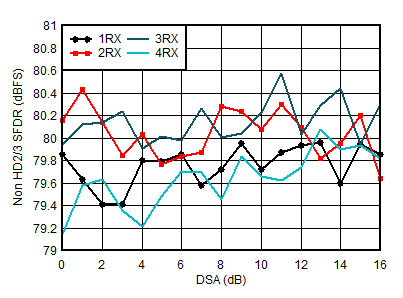 Figure 6-345 RX
Non-HD2/3 vs DSA Setting at 1.75 GHz
Figure 6-345 RX
Non-HD2/3 vs DSA Setting at 1.75 GHz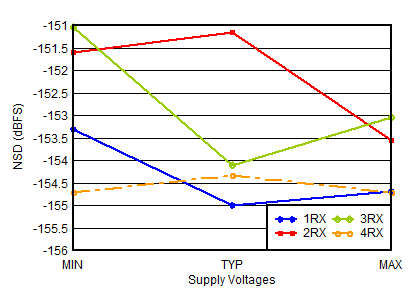
| With
1.8 GHz matching, 12.5-MHz offset, all supplies at MIN,
TYP, or MAX recommended operating voltages |
|
Figure 6-347 RX
Noise Spectral Density vs Supply and Channel at 1.75 GHz 




























